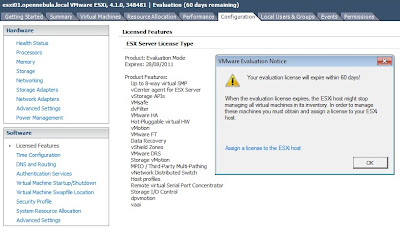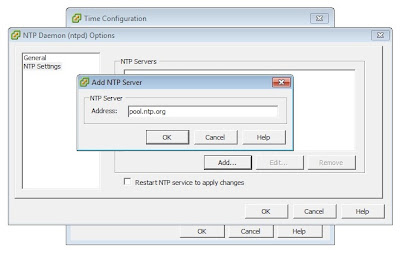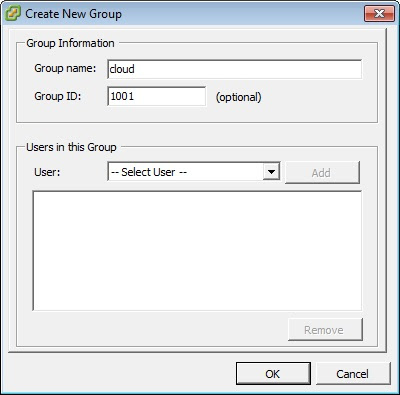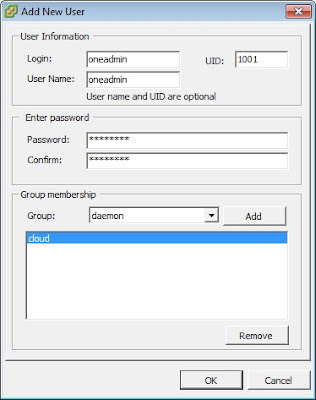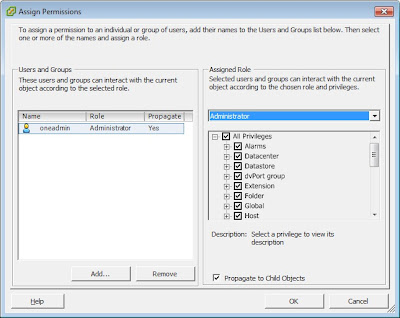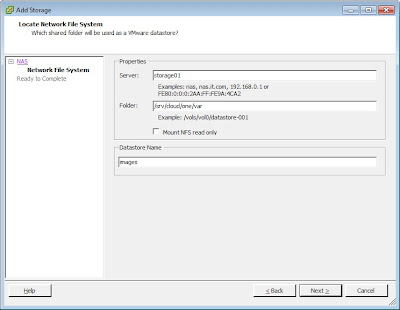Let's go ahead with the development of the cloud computing infraestructure based on
OpenNebula by
adding a VMware ESXi hypervisor. In the previous article, we saw how to configure a VMware vSphere node and now, we are going to set up the needed part on
frontend01.
In order to manage the VMware node from OpenNebula, it is necessary to install libvirt on
frontend01, and on top of all that, this software must be compiled with the ESX support. In this way, you cannot use the corresponding package located in the Ubuntu repositories. I am going to utilize the 0.9.2 version of libvirt.
root@frontend01:~# aptitude install libgnutls-dev libdevmapper-dev libcurl4-gnutls-dev python-dev libnl-dev libapparmor-dev
root@frontend01:/tmp# wget http://libvirt.org/sources/libvirt-0.9.2.tar.gz
root@frontend01:/tmp# tar xvzf libvirt-0.9.2.tar.gz ; cd libvirt-0.9.2
root@frontend01:/tmp/libvirt-0.9.2# ./configure --with-esx --with-apparmor --sysconfdir=/etc --libdir=/usr/lib --sbindir=/usr/sbin --datarootdir=/usr/share --localstatedir=/var --libexecdir=/usr/lib/libvirt
root@frontend01:/tmp/libvirt-0.9.2# make ; make install
I have also compiled the source code with AppArmor support, so I have had to move the required files.
root@frontend01:/tmp/libvirt-0.9.2# mkdir -p /etc/apparmor.d/libvirt
root@frontend01:/tmp/libvirt-0.9.2# cp -a examples/apparmor/usr.* /etc/apparmor.d/
root@frontend01:/tmp/libvirt-0.9.2# cp -a examples/apparmor/TEMPLATE /etc/apparmor.d/libvirt/
root@frontend01:/tmp/libvirt-0.9.2# cp -a examples/apparmor/libvirt-qemu /etc/apparmor.d/abstractions/
root@frontend01:/tmp/libvirt-0.9.2# cat /etc/apparmor.d/usr.sbin.libvirtd
...
owner /srv/cloud/one/var/** rw,
}
root@frontend01:/tmp/libvirt-0.9.2# /etc/init.d/apparmor restart
Next step is to download and install the VMware Drivers Addon (version 2.2.0 in my case). This wrapper enables the communication between OpenNebula and VMware ESXi through libvirt. This operation must be effected by means of the
oneadmin user.
When you run the
install.sh script and if everything went well, you will get a message about a specific code that you have to add into the
oned.conf file.
oneadmin@frontend01:/tmp$ wget http://dev.opennebula.org/attachments/download/350/vmware-2.2.0.tar.gz
oneadmin@frontend01:/tmp$ tar xvzf vmware-2.2.0.tar.gz ; cd vmware-2.2.0
oneadmin@frontend01:/tmp/vmware-2.2.0$ ./install.sh
VMWare Drivers Addon successfully installed
# After the installation, please add the following to your oned.conf file
# and restart OpenNebula to activate the VMware Drivers Addon
#-------------------------------------------------------------------------------
# VMware Driver Addon Virtualization Driver Manager Configuration
#-------------------------------------------------------------------------------
VM_MAD = [
name = "vmm_vmware",
executable = "one_vmm_sh",
arguments = "vmware",
default = "vmm_sh/vmm_sh_vmware.conf",
type = "vmware" ]
#-------------------------------------------------------------------------------
#-------------------------------------------------------------------------------
# VMware Driver Addon Information Driver Manager Configuration
#-------------------------------------------------------------------------------
IM_MAD = [
name = "im_vmware",
executable = "one_im_sh",
arguments = "vmware" ]
#-------------------------------------------------------------------------------
#-------------------------------------------------------------------------------
# VMware Driver Addon Transfer Manager Driver Configuration
#-------------------------------------------------------------------------------
TM_MAD = [
name = "tm_vmware",
executable = "one_tm",
arguments = "tm_vmware/tm_vmware.conf" ]
#-------------------------------------------------------------------------------
Due to there is a mistake in the
install.sh script, you must execute manually the following two orders.
oneadmin@frontend01:/tmp/vmware-2.2.0$ mkdir -p $ONE_LOCATION/var/remotes/im/vmware.d && cp -r im/remotes/* $ONE_LOCATION/var/remotes/im/vmware.d
oneadmin@frontend01:/tmp/vmware-2.2.0$ mkdir -p $ONE_LOCATION/var/remotes/vmm/vmware && cp -r vmm/remotes/* $ONE_LOCATION/var/remotes/vmm/vmware
This problem causes that you cannot start the VMware node up and the log file will show the next error.
oneadmin@frontend01:~$ cat var/oned.log
...
[ONE][E]: syntax error, unexpected $end, expecting VARIABLE at line 2, columns 1:2
Before restarting OpenNebula, you must type the user and password used to access to
esxi01 and include a line into the
sudoers file, so that OpenNebula may properly set some permissions.
oneadmin@frontend01:~$ cat etc/vmwarerc
...
USERNAME = "oneadmin"
PASSWORD = "xxxxxx"
root@frontend01:~# cat /etc/sudoers
...
oneadmin ALL=NOPASSWD:/srv/cloud/one/share/hooks/fix_owner_perms.sh ""
root@frontend01:~# /etc/init.d/opennebula restart
So as to check the correct installation, run the following command. Thereby, you will be able to obtain the physical resources of the managed node.
oneadmin@frontend01:~$ lib/remotes/im/run_probes vmware esxi01
/srv/cloud/one/lib/ruby/vmwarelib.rb:26: warning: already initialized constant ONE_LOCATION
/srv/cloud/one/lib/ruby/vmwarelib.rb:32: warning: already initialized constant RUBY_LIB_LOCATION
HYPERVISOR=vmware TOTALCPU=100 CPUSPEED=3001 TOTALMEMORY=2096460 FREEMEMORY=1677168
Now if you want to add the VMware vSphere node configured to OpenNebula, you can execute the next order.
oneadmin@frontend01:~$ onehost create esxi01 im_vmware vmm_vmware tm_vmware
oneadmin@frontend01:~$ onehost list
ID NAME CLUSTER RVM TCPU FCPU ACPU TMEM FMEM STAT
0 esxi01 default 0 100 100 100 2G 1.6G on





